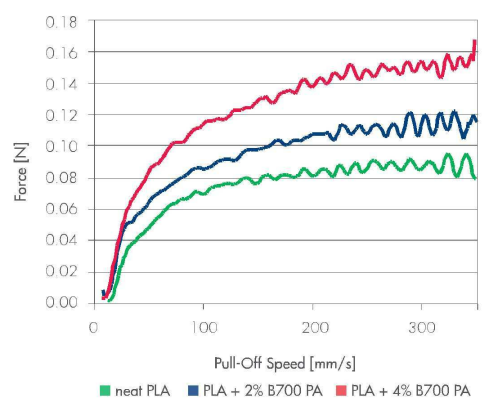Enhanced TDS
Identification & Functionality
- Chemical Family
- Function
- Impact Modifier
- Plastics & Elastomers Functions
- Product Code
- MITM10312
- Technologies
- Product Families
Features & Benefits
- Materials Features
- Product Benefits
- Optical Properties - Biostrengin® 700 copolymer is transparent in PLA at typical use levels
- Melt Strength - Biostrength® 700 copolymer increases melt strength of PLA for improved processing during extrusion, calendering, blow molding, thermoforming and injection molding.
- Necking and Sagging of Melt - Biostrength® 700 copolymer decreases sagging and necking phenomena of the PLA melt, providing greater ease in processing and higher quality finished arlicles.
- Regrind PLA and Poor Drying - Biostrength® 700 copolymer can be used to compensate for losses in melt strength when using high levels of regrind PLA or with insufficient drying of PLA
Applications & Uses
- Compatible Polymers & Resins
- Plastics & Elastomers Processing Methods
- Product Applications
Biostrength® 700 copolymer is recommended for use in PLA for applications where improvements in melt strength and ease of processability are desired. Typical use levels range from 1% to 5% by weight. Prospective clients should evaluate Biostrength® 700 copolymer in their own laboratories to establish optimum conditions for use in their processes and applications.
Properties
- Physical Form
Technical Details & Test Data
- Rheotens Analysis
Rheotens Analysis of PLA (170° C)

Packaging & Availability
- Packaging Type
Principal Information
- Group Principal Number
- S000003
- Principal
Other
- Appearance
- White powder
- Color (SDS)
- White
- Insoluble in (SDS)
- Water
- Item Number
- Odor (SDS)
- None
- Other Hazards
- Processing may release vapors and/or fumes which cause eye, skin and respiratory tract irritation, Prolonged or repeated exposure may cause: headache, drowsiness, nausea, weakness, (severity of effects depends on extent of exposure).
- Temperature Control
- No
- USA/DOT UN Number
- Not Applicable
- Application Information
Value Units Test Method / Conditions Dosage (Use Level) 1.0-5.0 % % - Material Composition
Value Units Test Method / Conditions Volatile Content max. 1.2 % % - Physical Properties
Value Units Test Method / Conditions Bulk Density 0.45 g/cm³ g/cm³ Sieve Fractionation (Retained) max. 2.0 % % 40 Mesh Specific Gravity 1.17 - - SDS Physical and Chemical Properties
Value Units Test Method / Conditions Autoignition Temperature (SDS) 878.0 °F °F Decomposition Temperature (SDS) 572.0 °F °F Density (SDS) 1.17 g/cm³ g/cm³ at 25°C Specific Gravity (SDS) 1.17 - at 25°C, Water = 1, liquid - Shelf Life & Stability
Value Units Test Method / Conditions Shelf Life 0.0 d d
